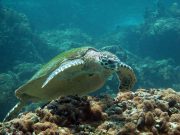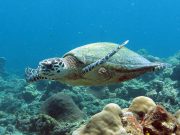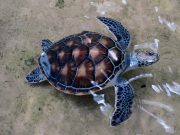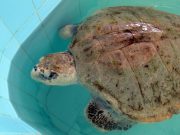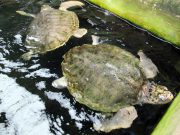There are 5 sea turtle species found in Thai waters: Leatherback, Olive Ridley, Loggerhead, Green and Hawksbill. All species are protected under the Thai Wildlife Protection Act of 1992. Some, such as the Hawksbill Turtle are a critically endangered species, and can be seen at most coral reefs while diving Koh Lanta.
The five species found in Thai waters can be identified as follows:
- Pattern of Carapace (Shell)
- Leatherback Turtle - 5 distinct ridges, no scutes
- Green, Hawksbill, Loggerhead, Olive Ridley - no continuous ridges, shell plates
- Lateral Scutes
- Green and Hawksbill - 4 pairs lateral scutes, first lateral not close to neck lateral
- Loggerhead - 5 pairs lateral scutes, first lateral close to neck lateral
- Olive Ridley - 6 to 8 pairs of lateral scutes, first lateral close to neck lateral
Males have longer tails than females, and most of the turtles we have recorded around Koh Lanta are females.
The Sea Turtle Hatchery and Nursery at Phang Nga Naval Base was started in 1995 and now releases over 10,000 turtles a year to the sea. The eggs are hatched on Hooyong Island in the Similans, collected immediately after emerging from the nest, and transferred to nursery.
In the world, less than 0.1% of turtle hatchlings survive to adulthood, whereas 40% of the hatchlings from the Royal Thai Navy Sea Turtle Conservation Center Phang Nga Naval Base survive to adulthood.
Information on this page from the Sea Turtle Conservation Center, Phang Nga Naval Base, Khao Lak
3 species found on this page.
Hawksbill Turtle
(Eretmochelys imbricata)
The hawksbill turtle is easily identified by its sharp hawk-like hooked-beak, and yellowish-brown visibly overlapping scutes on it carapace (shell). The beauty of its scutes has resulted in excessive hunting for accessories production.
Eretmochelys imbricata @ Koh Bida
Their habitat is coral reefs and they eat bubble corals, sponges, sea snails and various marine animals. This turtle is critically endangered.
Hawksbill Turtle @ Koh Rok
Divers with Hawksbill Turtle @ Koh Bida
Some of the sponges and small animals that hawksbill turtles eat contain toxic substances. The turtles are not affected by these toxins, however these chemicals are collected in their body fat, and may pose a serious risk to humans who eat turtle meat.
The maximum size of hawksbill turtles is around 95cm and maximum weight around 60kg.
Hatching area in Thailand: Thai Gulf and Andaman Coast.
Green Turtle
(Chelonia mydas)
Green Turtles have a large pair of brown and white paddle-like flippers with maximum size of maturity is 120cm. And maximum weight is 150 kg. Its habitat is coastal areas, sea grass and seaweed are its main food and its spawning sources in Thailand are in beaches of Kram Islands, Similan Islands, Adang-Ravi Islands and Kra Island.
Juvenile Chelonia mydas @ Phang Nga
Green turtles begin their lives eating plants, fish and jellyfish, but become vegetarians as they grow older.
Adult Green Turtles @ Phang Nga
2 week old Green Turtle @ Phang Nga
Green turtles have yellow-brown shells reminiscent of the sky at sunset. They have the hardest shell in the world.
Hatching area in Thailand: multiple locations in both Thai Gulf and Andaman Coast.
Green turtle is named after the colour of their cartilage and fat. Lifespan in the wild up to 80 years.
Females nest at intervals of 2 -4 years, with average of 3 - 5 nests per season. Around 115 eggs are laid in each nest, with incubation period of around 60 days.
Green turtle photos taken at the:
- Sea Turtle Conservation Center, Phang Nga Naval Base, Khao Lak
- Thai Muang Turtle Sanctuary "Turtle Heaven", Phang-nga Coastal Fisheries Research and Development Center, Phang Nga
Olive Ridley Turtle
(Lepidochelys olivacea)
Olive Ridley Turtle is a small sea turtle with an adult carapace length of 75cm and its maximum weight is 50kg. The carapace is grey with 6-9 pairs of lateral scutes, its habitat is coastal area and small marine animals such as shrimp, shellfish, crab and fish are its food.
This turtle lives in the seas around Koh Lanta and all of our dive sites, and can be seen during boat trips to/from dive sites, but it rarely seen on the actual dive sites.
Lepidochelys olivacea @ Phang Nga
Olive Ridley Sea Turtle has spawning behaviour different from other sea turtles. Huge groups of 1,000 - 10,000 female turtles gather together to spawn simultaneously, called the ‘Arribada’ phenomenon in Orissa State in India.
There is no ‘Arribada’ phenomenon in Thailand ,but its spawning source is in the west coast of Phuket and Phangnga provinces.
Olive Ridley Turtle @ Phang Nga
The Olive Ridley Turtle has a smooth grey-green shell and a big beak. It is the smallest species of sea turtles.
The diet consists of sea weeds and sea creatures like shrimps and snails.
The hatching area in Thailand is the Andaman Coast, though we don't see them here on Lanta's beaches.
Diet: Omnivore, molluscs and crustacean. Nests 3 times annually with 100 - 110 eggs per nest. Average life expectancy is 50 years.
Olive Ridley Turtle photos taken at the:
- Sea Turtle Conservation Center, Phang Nga Naval Base, Khao Lak
- Thai Muang Turtle Sanctuary "Turtle Heaven", Phang-nga Coastal Fisheries Research and Development Center, Phang Nga

